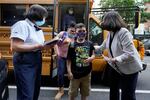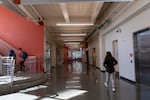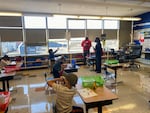
Students are greeted as they arrive at PS811 in New York, Monday, Sept. 13, 2021. School started Monday for about a million New York City public school students in the nation's largest experiment of in-person learning during the coronavirus pandemic.
Richard Drew / AP
In the middle of Oregon’s worst wave of COVID-19 cases to date, school is back in session. For more than a month, more than 2,000 new cases have been reported each day, with most days approaching 2,500.
The delta-caused wave might be peaking in Oregon, but the surge is far from over.
In March 2020, concerns about the new coronavirus led Oregon officials to shut down schools across the state, sending hundreds of thousands of students to study online. Later last year, as case numbers became more manageable, state leaders required schools to reopen with at least a hybrid model. But a year and a half of distance-learning and social isolation has taken its toll on many students’ mental health, and vaccines are widely available. That means this year, school in Oregon is fully in-person.
“The good news is, we proved that schools can be in session in person and still mitigate the spread of COVID-19,” said Colt Gill, the director of the Oregon Department of Education, in a press conference Sept. 7.
But that proof Gill cited was before delta. In practice, reopening hasn’t been smooth.
Some districts delayed their first days of school, because there weren’t enough teachers or school staff or bus drivers available to operate. Others, such as the coastal districts of Neah-Kah-Nie and Tillamook, have gone remote in the face of mounting cases and staff shortages. Some districts are continuing with business as usual. Teachers and parents alike are asking: is it possible to safely open schools, while following all guidelines, in the middle of an unprecedented surge in cases?
“If we had everyone masked, and the age-eligible were fully vaccinated, and we had consistent 3- to 6-feet distancing, and excellent, better ventilation, we would be at very, very low risk,” said Dawn Nolt, the medical director for infection prevention and control at Oregon Health and Science University. “But we don’t. So we try to do what we can, and try to layer as much protection as possible.”
A different calculus
There are two major differences between the last time schools reopened, and this one: the delta variant, and vaccines. The mRNA-based COVID-19 vaccines are among the most effective vaccines ever made, dramatically reducing the chances of becoming severely ill, and reducing the chance of infection.
But the delta variant is much more contagious than previous variants. It offsets any gains the vaccine made towards slowing transmission. The difference is that now, a lot of people over 12 are unlikely to get sick, and less likely to die or be hospitalized than before, because they are vaccinated.

A hallway is mostly empty after students go to first period on Sept. 1, 2021, at Kellogg Middle School in southeast Portland .
Elizabeth Miller / OPB
“Both major statistics and state statistics show that in August, around 10% of the newly infected were children under 12, because they cannot be vaccinated,” said Chunhuei Chi, the director of the Center for Global Health at Oregon State University. “That statistic is both alarming, but also very complicated.”
Children are much more resistant to COVID-19 than adults are — that’s the opposite of other diseases, like whooping cough and the flu. The chances of a child under 12 dying from COVID-19 are very low, but children are now more likely to be infected with the coronavirus than they were before the delta variant.
“From a parent’s point of view, that’s a steep increase in the risk,” Chi said. He understands why some find it alarming.
Each parent will weigh it differently, depending on their own risk-aversion and how fast the coronavirus is spreading locally. And there’s another layer for families to consider: children aren’t the only people who can get infected. A kid who gets sick in school could bring the virus home, and expose unvaccinated or high-risk relatives.
The safety protocols
It’s not an understatement to say that the delta variant of COVID-19 changed everything, but risk can be hard to understand. What does it mean, for a virus to be more than twice as infectious as the first version? And for a person infected with delta to shed ten times more virus?
To get an idea of just how infectious the delta variant is, consider masks: For over a year, unvaccinated people relied on masks to stay safe. Some of those masks are flimsy, just one or two layers of cloth. Others are loose, fit poorly, and fall off people’s noses.
For a while, said Chi, that could offer decent protection. Our body has good natural defenses against viruses and bacteria, even ones we haven’t encountered before. If a cloth mask filters, say, 40% of all viruses, an unvaccinated person’s body might kill them all before they can be infected.
But if an unvaccinated person infected with delta sheds 10 times as much virus, filtering out 40% might not cut it anymore: a hypothetical person is more at risk of contracting delta while wearing a sub-par mask than they were of contracting the first variant with no protection at all. The chances of some virus getting past their frontline defenses increases.
Similarly, because a person with delta is more infectious, it takes less time to breathe in enough virus to get sick, and the circle of infection gets larger. It’s still unclear exactly how that new math shakes out, though.
“I’ve heard from colleagues anecdotal — not based in science, necessarily — that rather than requiring 15 minutes within 24 hours for a close contact, that maybe it’s as low as five,” Nolt said, “I could see that being a concern. But at this point, we’ll stick with the recommendation of keeping 6 feet of distance.”
Masks are just one of the protective layers that public health officials and school administrators are relying on to minimize spread of the delta variant. Social distancing also plays a part. In spring 2021, citing new data showing that schools were low-risk environments, the CDC lowered their recommended distance for schools from 6 feet to 3 feet.
And that’s 3 feet from person to person, not 3 feet from desk to desk.
Nolt emphasized that the 3-foot distance set by the CDC is a minimum. Farther is always better, but some schools just don’t have the classroom space necessary to keep students 6 feet apart.

Gov. Kate Brown visits Scott Elementary students on the first day of hybrid learning April 1, 2021.
Elizabeth Miller
“What we have to understand is that we can’t remove risk, we just have to reduce it,” Nolt said.
Chi has spent much of the pandemic looking at different strategies used in communities around the world. He says the best thing schools can do is move as many activities outside as possible, while also keeping windows open, masks on, and distributing HEPA filters to classrooms.
Chi also noted that a 3-foot distance can be safe — but only if people are wearing protective masks correctly. That means no air leaks around the nose or chin and no loose masks. It’s also only safe if the masks are good ones — either N95s, or fabric masks engineered to give a similar level of protection.
However, teachers can tell you that keeping students 3 feet apart and getting them to keep their masks properly on their faces isn’t always easy (adults struggle with this, too). There will be in-school transmission, it’s unavoidable.
Testing our way out
There are two types of testing offered in Oregon schools — other than the assessments that teachers regularly spring on their students. The first is testing for students who are showing symptoms of illness. Symptomatic testing uses a rapid test that gives results in a matter of minutes. If a child gets sick at school, they get a rapid test and the school can figure out who to quarantine.
“That is the most important type of testing,” Nolt said.
But testing only people showing signs of illness doesn’t detect students or staff members who may have COVID-19 and not have symptoms.
That’s where screening comes in: the state runs a program that allows individual classes, schools and clubs to sign up to be tested once a week. These are PCR tests that are collected at school, and then sent to a local lab partner to be processed.
Nolt said that weekly screenings will catch some asymptomatic COVID-19 infections, but that screening becomes less effective as cases increase. It’s a snapshot in time, so it only catches people who were infected in the right time frame.
For the same reason, Nolt said, screening is only effective if the turnaround time is very quick — if you don’t get results for three or four days, most students will have already developed symptoms and could have passed the virus on to others. The effectiveness of Oregon’s program relates directly to how fast the local laboratory can process the tests.
Screening students once a week will help — movie sets have operated somewhat successfully with once-a-week testing and similar protocols, during times when COVID-19 cases are low. But even daily screenings couldn’t keep COVID-19 out of the White House.
That’s because all these safety measures work best if they’re applied as strictly as is realistically possible. In Oregon, state officials are leaving a lot of decision-making up to the districts this year. Masking, for example, is a state law. There’s no law requiring lunch or physical education to be held outside. Both testing programs are opt-in. Different schools will have different levels of ventilation and different space limitations.
Even with all of those caveats, schools still have one big thing going for them: they’re not the outside world.
“We hope schools are controlled environments. That means they’re a lot safer than the general community,” Nolt said.
That means the best way to keep kids safe, and schools open, is to lower the rate of COVID-19 in communities. And the ways to do that are still the same as they have always been: by wearing masks, avoiding large gatherings, staying home when you’re sick, and getting vaccinated.
Stay in school, kids
“We want our kids to be in person. We know they learn better, we know they learn more,” Nolt said.
The last 18 months have thrown the importance of social interaction into the spotlight. The isolation that comes from the pandemic has been hard for everyone, but it’s been particularly hard on young people.
However, with high levels of community circulation, keeping students in school involves more than keeping them healthy.
“Access to school is constantly under threat due to exposure to individuals with the highly contagious delta variant,” said Gill. Students who are exposed could need to quarantine — and then they miss school time.
And when staff are exposed, in quarantine, or sick, it can be impossible to run school safely. At least 10 school districts have delayed their reopening due to COVID-19 or have started the school year remotely, citing shortages of staff, a high number of students in quarantine, and disrupted learning.
People are still just as likely to be exposed to the coronavirus as they ever were, if not more. And although data shows that cases in schools seem to follow cases in the community — not the other way around — there’s still a real concern that with the delta variant, school transmission could drive up transmission in the community.
There’s every reason to hope it won’t. Unlike the flu or the cold, schools do not appear to play a large role in driving transmission of the coronavirus. But hospitals are at capacity, and although the state’s new mask mandates seem to have stopped the number of new cases reported each day from rising, those numbers have yet to fall.
All evidence shows that when it comes to preventing COVID-19 in schools, the most important work happens outside of the classroom.
“Schools are just another part of the community. So what we’re seeing in the community is going to be reflected in what we’ll see in schools,” Nolt said.
Nolt has one more ask. It’s one that could take months to have any benefit, but will make the biggest difference: “If you know someone who is not vaccinated, talk to them.” Not argue: talk.
Possibly, talk to them several times. “It’s not going to be a slam dunk. ‘Oh, my goodness! I’m going to say the right phrase that will completely turn their mode of thinking’ — that’s not going to happen. Just be patient, and be willing to talk, and be willing to listen.”